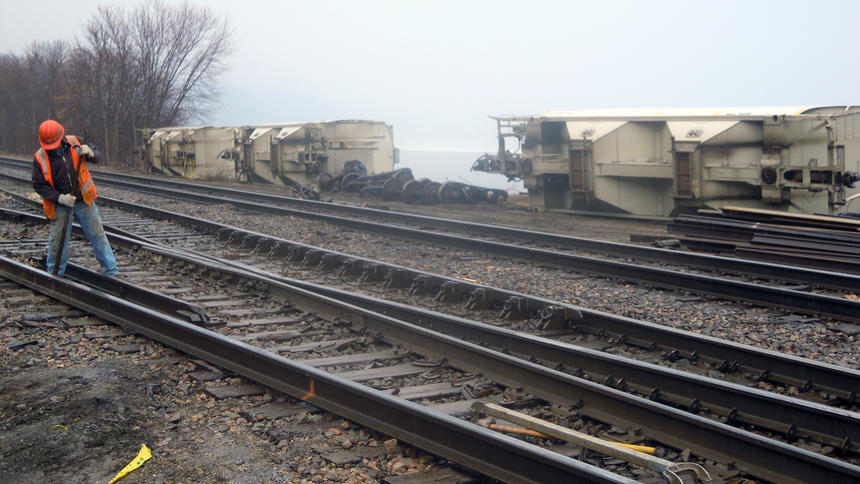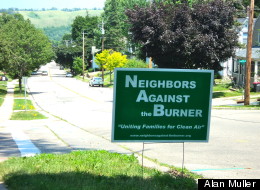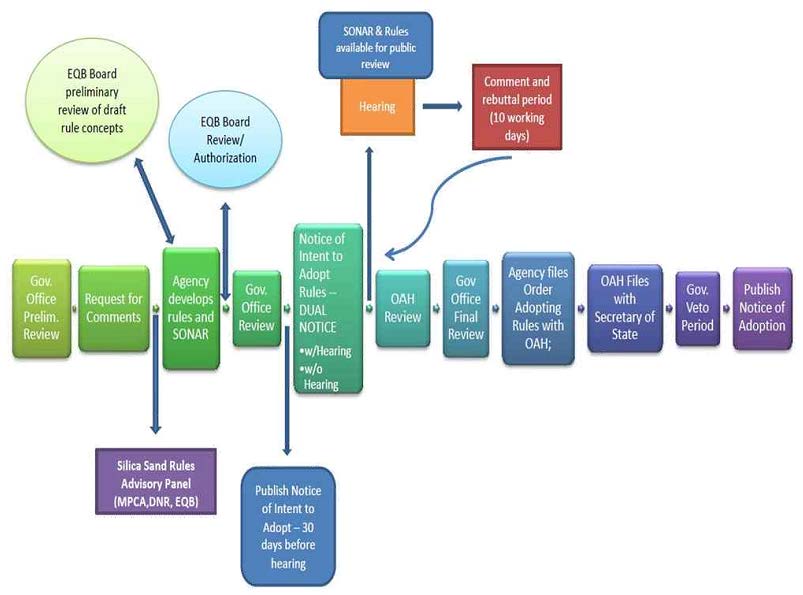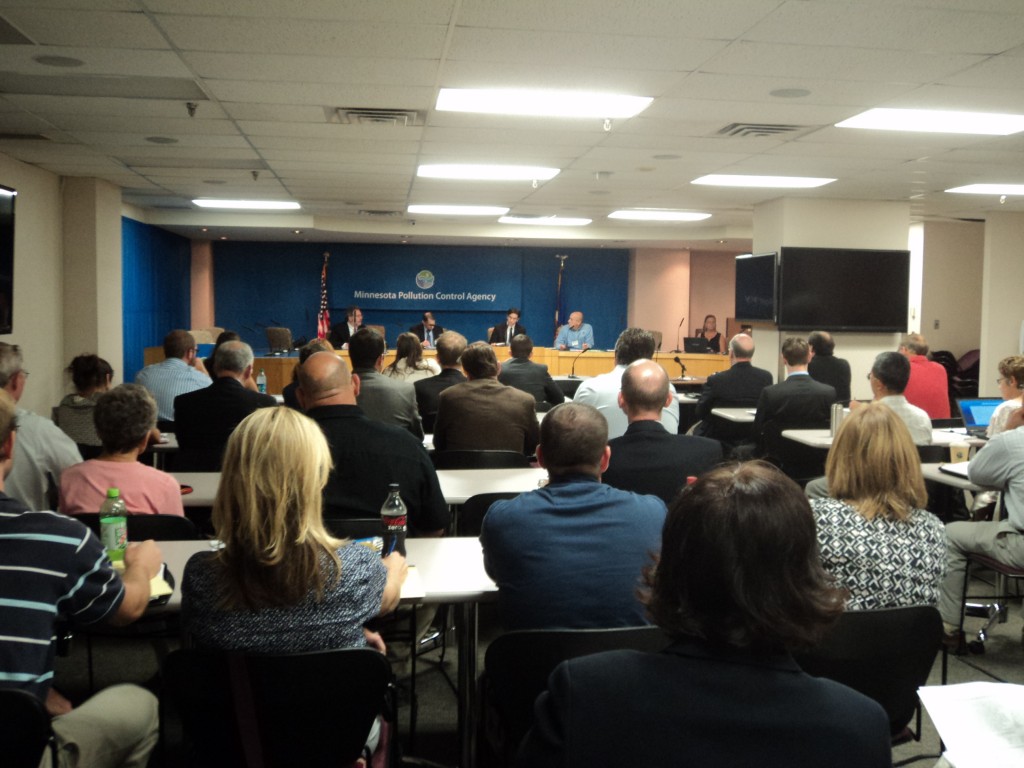Silica Sand Rulemaking — Mtg. Thursday 8/28
August 26th, 2014
 It’s that time again — the Silica Sand Advisory Committee is meeting again on Thursday, from 10 a.m. to 3:30 p.m. at the People’s Energy Cooperative in Oronoco, Minn.
It’s that time again — the Silica Sand Advisory Committee is meeting again on Thursday, from 10 a.m. to 3:30 p.m. at the People’s Energy Cooperative in Oronoco, Minn.
Here’s the Agenda:
Agenda
Dig this:
In my experience, the search/stretch for consensus is the first step in unreasonable compromise. It takes a push to change things, and it’s important not to give up too soon.
As you know, I’ve been frustrated at the way these meetings are handled, in that they’re NOT doing what a rulemaking advisory committee is supposed to do, which is review and comment on draft rules. And we’re not getting representation on this committee, there are no regular updates from members that I’m aware of, unless I ask on a list, so we’re not getting any opportunity for input or feedback from the representatives. Plus there’s Charlie Peterson…
I was listening to the July meeting, and for introductions, there were only six members of the committee present:
Tara Wetzel – MN Aggregate Ready Mix Assoc.
Beth Procter – Lime Twp., Blue Earth County
Al Frechette – Scott County
Doug Losee – Unimin
Tom Rowekamp – IT Sand
Kelly Stanage – Citizen Rep. from Houston County
I’ve heard from Amy Nelson that she, Keith, and Vincent Ready were there. Katie just let me know she was there. Others? Were introductions not broadcast? Did anyone come in later? Can’t tell, it was audio only (unless I’m missing something), and the audio was out for a large part of the presentation. Where are the alternates? Where are the alternates? And if members are determining that it’s a big waste of time and don’t want to show up, well, it seems they ought to let the agencies know so replacements can be found! And so the meetings can be changed to become more ___________ and less _________ so members can and will attend!
Here’s the bright spot of the day, from what I’ve seen:
Look where they put the “Advisory Panel.” IT’S IN THE RIGHT PLACE!!! YES!!! Now, there needs to be another arrow, though, or a expansion of the purple square that says, “Advisory Panel review of draft rules.” They’re sidestepping by saying that, even the EQB Board, will “review draft rule concepts.” NOPE, not good enough, eliminate that word “concepts” and let’s start reviewing rules, the Advisory Panel and the EQB. DRAFT RULES! It’s that simple.
From the site, here are the future planned meetings:
An August Weds & Thurs at MPCA
September 10th, 2012
Wednesday, August 29th and Thursday, August 30th at the MPCA were days focused on the Range. (yes, it’s taken forever to get this posted)
Wednesday, August 29th was the “Haze Day” at the MPCA, a hearing held by the federal Environmental Protection Agency because it wants to take back the MPCA’s haze regulatory authority and adopt rules. The MPCA has had a very, very long time to deal with this, and hasn’t done the job. Here’s the MPCA page:
Comments are due
Meanwhile, in a different venue, there’s a federal lawsuit afoot:
And then on Thursday, August 30, it was all about greenhouse gas emissions, but for only a handful of facilities, taconite plants on the range. This one was really bizarre. It started with the MPCA’s Ass. A.G. running down the “jurisdictional” exhibits to enter into the record. Alan and I were the last in, and signed on page 3 of the sign in sheet. They had much needed coffee, and some great macadamia nut white chocolate cookies. The Asst. A.G. noted in his presentation (and he seemed to have zero familiarity with the exhibits) that it did not meet the notice requirements but that he regarded it as harmless error and wanted a finding from the judge to that effect. I was in the back of the room, and noted more empty chairs than there were the day before, and got to wondering…
Starting at the beginning, here is the MPCA page for the greenhouse gas rules for taconite plants on the Range:
When I testified, I had a few questions, and learned that the Notice and list of those receiving notice, and some of the other “jurisdictional” documents were not available online.
If notice was not adequate, as the Asst. A.G. stated, twice, maybe more, then they’ve got a problem under Minnesota’s admnistrative law:
Subd. 1a.Notice of rule hearing.
(1) their electronic mail address; or
…oops… and not only that:
14.50 HEARINGS BEFORE ADMINISTRATIVE LAW JUDGE.
All hearings of state agencies required to be conducted under this chapter shall be conducted by an administrative law judge assigned by the chief administrative law judge or by a workers’ compensation judge assigned by the chief administrative law judge as provided in section 14.48. All hearings required to be conducted under chapter 176 shall be conducted by a compensation judge assigned by the chief administrative law judge. In assigning administrative law judges or compensation judges to conduct hearings under this chapter, the chief administrative law judge shall attempt to utilize personnel having expertise in the subject to be dealt with in the hearing. It shall be the duty of the judge to: (1) advise an agency as to the location at which and time during which a hearing should be held so as to allow for participation by all affected interests; (2) conduct only hearings for which proper notice has been given; (3) see to it that all hearings are conducted in a fair and impartial manner. Except in the case of workers’ compensation hearings involving claims for compensation it shall also be the duty of the judge to make a report on each proposed agency action in which the administrative law judge functioned in an official capacity, stating findings of fact and conclusions and recommendations, taking notice of the degree to which the agency has (i) documented its statutory authority to take the proposed action, (ii) fulfilled all relevant procedural requirements of law or rule, and (iii) in rulemaking proceedings, demonstrated the need for and reasonableness of its proposed action with an affirmative presentation of facts.
Oops again!
Anyway, here is what they sent me in response to my request for the Exhibits (particularly the notice exhibits, 6 and 7):
Minnesota PCA Jurisdictional Document Title Table of Comments
Exhibit 1: Request for Comments Notice (aq-rule4-05a)
Exhibit 2: Revisor’s Extract of Proposed Rules (aq-rule4-05d)
Exhibit 3 – the SONAR and links
Exhibit 4:
Exhibit 5:
Exhibit 6 – Subscribers of Rulemaking: Federal Air Permit Thresholds for Greenhouse Gases Rule:
Exhibit 7? – Subscribers of Air Regulatory and Technical Information, Rulemaking: Federal Air Permit Thresholds for Greenhouse Gases Rule:
Exhibit 8: Comments received on proposed Greenhouse Gas Rule (aq-rule4-05r)
Alan was in Huff Post Monday!
July 4th, 2012
Alan Muller had a few more minutes of recognition for his work against incinerators.
The MPCA made its decision at the Board’s June 26 meeting, Alan’s testimony is kick-ass as usual, starting around 2:47. The Cottage Grove part starts about an hour into the webcast:
This time, it’s the Cottage Grove 3M Incinerator in Huffington Post this week:

(that’s a NAB sign out in front of our house, Barn Bluff visible way down the hill in the distance…)
3M Incinerator Can Burn Outside Hazardous Waste, Minnesota Says In Defeat For Residents
Bets Thorkelson’s opposition to 3M Co.’s hazardous waste incinerator began in the mid-1990s, when she learned that four moms of boys on her sons’ hockey team had breast cancer.
“About the same time, I had also noticed that many people on my street were starting to die of cancer, including a young boy from a form of lymphoma,” said Thorkelson, who lives in what she describes as a blue-collar neighborhood in Cottage Grove, Minn., about two miles from one of the St. Paul-based mega-corporation’s factories.
Her distrust of 3M grew when she received a diagnosis of breast cancer herself a decade later. And it mounted further when she heard about the company’s plans to truck in additional hazardous waste to use as fuel for an incinerator.
Last week, after three years of public meetings, petitions and pleas from Thorkelson and other residents, the Minnesota Pollution Control Agency approved a permit to burn non-3M waste, as well as materials confiscated by local law enforcement agencies, allowing the company to save as much as $2 million in natural gas. Neighbors said they fear it will add lead, mercury and other toxic pollutants to the air they breathe — on top of the water and soil contamination already blamed on the company.
No link has been proven between past 3M pollution and cases of cancer. However, the state of Minnesota is suing 3M over claims that the company polluted groundwater and surface water for more than 50 years with perflurochemicals, which scientific studies have suggested may cause cancer.
“The [incinerator] decision is very disappointing, though not surprising,” Thorkelson said. “Our community has now become the toxic dumping ground for U.S. industries.”
Knowing the permit would be controversial, the state Pollution Control Agency decided to involve residents in discussions concerning the permit, according to the agency’s Jeff Smith. “At the heart of the issue was whether the public felt like they were enough part of the process so that they were informed and had a say,” Smith said. “Over 15 additional restrictions that might not otherwise have been required were negotiated between citizens, the city and the company. At end of the day, we overachieved in involving the public.
“There will be no additional increases in pollutants beyond what 3M has been permitted to emit,” added Smith.
Representatives from 3M also emphasized that the air pollution coming out of their incinerator with the additional hazardous waste would not rise above historic levels , thanks mostly to updated equipment that traps most of the particles.
But are the regulatory limits enough to protect Cottage Grove children from developmental problems, asthma, even cancer? And were 3Ms historic pollution levels ever safe?
Alan Muller, who once promoted incinerators for DuPont, said he shares the community’s concerns over uncertain answers to both questions. He now helps advise opposition groups, including the Coalition of Concerned Cottage Grove Citizens.
“For every pound of lead that goes into the incinerator, a pound comes out,” said Muller. Toxic metals can’t be broken down like other particles, he explained, so they will either spew from the smokestack, end up in the ash that’s trucked to a landfill, or get treated with the plant’s scrubber water before winding up in the Mississippi River.
A little lead can potentially cause a lot of harm, especially to a child’s developing brain. The U.S. Centers for Disease Control and Prevention recently acknowledged the risks by lowering the threshold for lead poisoning.
“It’s not that hard to find out hazardous waste incinerators are a bad scene. But this is a political, not a tech, issue,” said Muller. “The idea of weakening environmental regulations to revive the economy is not localized. Unfortunately, the same bogus arguments continue to be made all over the country.
“I never had a feeling that MPCA was acting in good faith on this,” Muller added. “Whenever you have a powerful corporation, with a lot of clout in the state, it’s hard for regulators to stand up to them.”
Fred Luden, a resident of Cottage Grove and a former 3M employee, returned from vacation in time to share his concerns at last Tuesday’s final hearing. He told the MPCA that it struck him while sitting on a lake with his grandkids just what a pristine environment he enjoyed while growing up in Minnesota, and how contaminated parts of the state have become today.
“You’d like to see at some point in time the ball go back the other way, to an environment that you can pass down to your children, grandchildren, great-grandchildren — hopefully,” said Luden, a member of the board of directors for the Coalition of Concerned Cottage Grove Citizens. “And that they will enjoy the same ability to drink the water, breathe the air, grow what they want in a garden and eat the fish again.”
That’s little comfort for some families who currently live in what they said is a contaminated environment.
“I have some peace of mind,” said Thorkelson, “knowing my grandchildren do not live within a 10-mile radius of the incinerator.”


